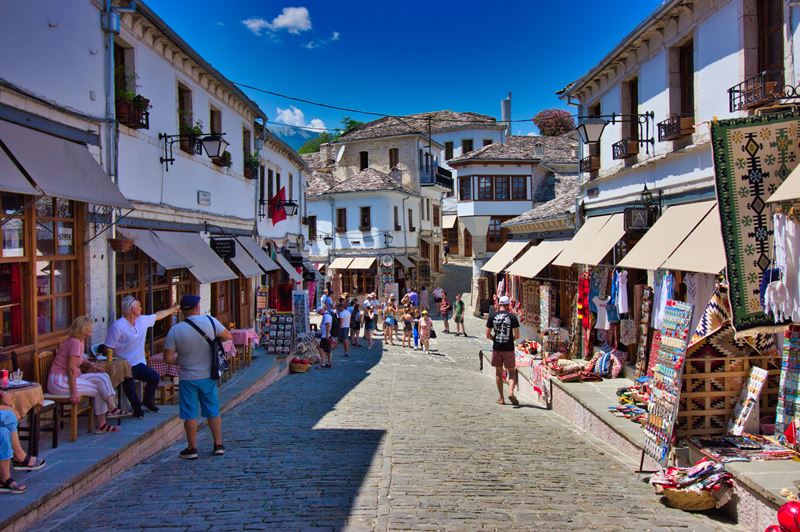Gjirokastra was declared a museum city in 1961 during the communist regime. It was good decision to preserve what is left in the city from the wars, invaders, and from degradation in years and decades. There were some restoration, the stone mosaics and some renovation in the bazaar, the castle, ethnographic museum. But the city deserved more.
During the troubled years of 97-98 the city was seriously damaged, no one cared about the houses and their importance. There was an alarming situation forced the municipality of Gjirokastra to seek help. The first help came from French Ministry of Culture, which gave the green light that the city could be part of UNESCO in order to win a protected status. According the to the former mayor of Gjirokastra Ylli Asllani, the process started in 1998 when they started a plan with the representatives of the association France-Albania and representatives of French Embassy in Tirana. They prepared together a formal request to be deliverd directly to UNESCO in a conference organized in the Palace of Bourbon, close to French Parliament. In fact it was not a request or a promotion of beautiful city of Gjirokastra, but a signal of alarm asking for help to protect this city, so the project was called Gjirokastra SOS, Allsani said in an interview for Albanian media. In this conference was present also the Albanian writer from Gjirokastra Ismail Kadare, who was very popular in France in that time, and our ambassador in UNESCO, Jusuf Vrioni. That conference was full of supporters that Gjirokastra should be inscribed in UNESCO. But after that moment, it was a list of requests to be fulfilled, documents, a process which lasted 5 years to prepare the nomination file. A hard work until the process was finalized was done by later ambassador Tatjana Gjonaj, which in fact worked in the same time for Berat city to be inscribed together as two cities with lot of similarities.
It was the year 2005, 15 years ago, when Gjirokastra become UNESCO property through a very welcoming and helping process from the representatives of UNESCO and all member countries of this organisation.
Here is what UNESCO says about the outstanding values of these two cities in Albania:
These two fortified historic centres are remarkably well preserved, and this is particularly true of their vernacular buildings. They have been continuously inhabited from ancient times down to the present day. Situated in the Balkans, in Southern Albania, and close to each other, they bear witness to the wealth and diversity of the urban and architectural heritage of this region.
Berat and Gjirokastra bear witness to a way of life which has been influenced over a long period by the traditions of Islam during the Ottoman period, while at the same time incorporating more ancient influences. This way of life has respected Orthodox Christian traditions which have thus been able to continue their spiritual and cultural development, particularly at Berat.
Gjirokastra was built by major landowners. Around the ancient 13th century citadel, the town has houses with turrets (the Turkish kule ) which are characteristic of the Balkans region. Gjirokastra contains several remarkable examples of houses of this type, which date from the 17th century, but also more elaborate examples dating from the early 19th century.
Berat bears witness to a town which was fortified but open, and was over a long period inhabited by craftsmen and merchants. Its urban centre reflects a vernacular housing tradition of the Balkans, examples of which date mainly from the late 18th and the 19th centuries. This tradition has been adapted to suit the town’s life styles, with tiered houses on the slopes, which are predominantly horizontal in layout, and make abundant use of the entering daylight.
Criterion (iii) : Berat and Gjirokastra bear outstanding testimony to the diversity of urban societies in the Balkans, and to longstanding ways of life which have today almost vanished. The town planning and housing of Gjirokastra are those of a citadel town built by notable landowners whose interests were directly linked to those of the central power. Berat bears the imprint of a more independent life style, linked to its handicraft and merchant functions.
Criterion (iv) : Together, the two towns of Gjirokastra and Berat bear outstanding testimony to various types of monument and vernacular urban housing during the Classical Ottoman period, in continuity with the various Medieval cultures which preceded it, and in a state of peaceful coexistence with a large Christian minority, particularly at Berat.
The overall integrity of the two towns is satisfactory, although this was adversely affected by illegal constructions in the late 1990s. Authenticity is also satisfactory, but preservation management must be stepped up and carefully enforced, in accordance with the highest international standards.
The management plan measures and the recently established coordination authority responsible for implementing the plan should encourage an active policy of preservation and conservation of the property’s Outstanding Universal Value, particularly as regards urban construction management and visitor facilities.

